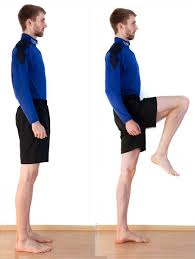
From Blog Article 2 (Hip Flexion v’s Lumbar Flexion), we know that hip flexion is possible by the contraction of one or more of the following muscle groups:
- Iliacus
- Psoas Major & Minor
- Rectus Femoris
- Sartorius
- Tensor Fascia Latae
- Hip Adductors (Pectineus, Adductor Longus, Brevis, Gracilis).
We also know that if the abdominal muscles are unable to adequately provide a stabilising role on the pelvis during any hip flexion activity, we will see the pelvis move into an Anterior Pelvic Tilt position (which increases the load/stress placed on the lumbar spine).

What are the abdominals’ role as stabilizers during Hip Flexion?
Their role is to minimise anterior pelvic tilt (which can be a default pelvic position with weak abs and/or excessively tight hip flexors).
Through contracting isometrically (Tension created but no lengthening or shortening of the muscles – See Concentric, Eccentric, Isometric contractions & the core), the abdominal group is able to maintain a neutral pelvic position whilst the hip flexor muscles can exert force to create the desired movement.
During activities that place anterior tilt pressure on the pelvis the abdominals play a role in maintaining a neutral pelvic position: These activities can include:

If you are not able to generate the correct abdominal contraction to maximise their stabilizer/fixator role, you will create significant forces within your Lumbar vertebra each time you try to perform exercises that load the core/hip flexion region.
Typical exercises performed in a gym that activate the abdominal muscles in their stabilizer role include:

Exercises that focus on lumbar flexion (with minimal hip flexion activation) include:


One of the challenges with performing exercises with a focus on core stability is that it is easy to overload the stabilising function by undertaking exercises that are too advanced. Once this happens, then the hip flexor muscle groups will begin to place potentially high shearing forces upon the lumbar verterbra in an attempt to complete the activity you are undertaking:
Example – Full Range Situps

As outlined in Blog Article No. 1 (Why can’t I do full range situps) – It is possible to complete a full situp (with feet anchored) and not have any lumbar flexion at all. The entire activity can be achieved by the hip flexors and if the client is not adequately strong in their core to stabilise their pelvis during this hip flexion activity, they will create high loads/shearing forces upon their lumbar vertebra resulting in pain, inflammation and ultimate degeneration of the joints in the lower back.
Example – Leg Lowers (Unilateral or Bilateral)

Unfortunately, this is a very popular exercise among gym goers.
There are many variations, some better, many worse (eg having legs pushed hard towards the floor by a partner!).
This is one of the most advanced abdominal exercise you can undertake.
The amount of pelvic stability required from your abdominal muscle group is very high and only a small portion of the population have the strength to lower their legs close to the ground whilst maintaining a neutral pelvic position.
Leg lowers can be used to provide feedback to the client on the level of their core stability strength.

A simple way of measuring your stabilizer core strength is to conduct a core stabilizer strength test using a device like the Isometric Abdominal Pressure Testing Device.

The device is placed under your lower back, inflated and you are required to contract your core to maintain this pressure as you perform several increasingly advanced leg raise/lowering activities (as you reach your core stability limit your hip flexors will increase their activation resulting in pulling on your lower back (causing arching) in turn lowering the pressure you can place on the pad).
If you don’t have access to such a device, then placing a hand under your lower back (yours or partner/trainer) will allow you to concentrate on keeping pressure on the hand whilst performing this testing protocol.
ABDOMINAL STABILITY TESTING PROTOCOL
- Place the pad/hand under your lower back.
- Position your straight legs at 90o (pointing towards the ceiling/sky).
- Record a pressure (device) or press on your hand and then start to slowly lower your legs towards the floor whilst trying to maintain this level of pressure.
- As soon as you are unable to maintain 80% of the initial pressure (or you can easily remove your hand from under your lower back) then the angle of your legs to the floor is approximated and that is the end of the test.
- If you are unable to lower your legs with pelvic control to ~35o then your core stability isn’t ready for advanced hip flexion/extension activities and you should continue to work on exercises that target core stability but in a way that minimised this lower back stress.
BEST CORE EXERCISES TO IMPROVE PELVIC STABILITY WHILST MINIMISING LOWER BACK LOADING.
- Partial range situps (Reach for the Sky situps)
- Unilateral Leg lowers with focus on pelvic stability
- All Plank variations – beginning with simple (floor) building up to swiss ball variations.
Like all training, there should be a progression of exercise intensity, giving your core the time to adapt to develop the stability required to safely perform more advanced hip flexion exercises.
My next article will outline an exercise progression that will ensure you develop the appropriate strength to safely perform advanced core training whilst minimising potential damage to your lower back (lumbar vertebra).


